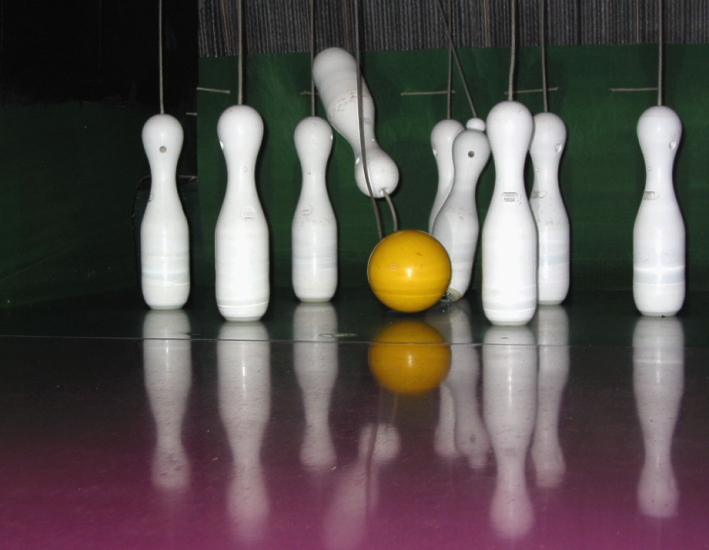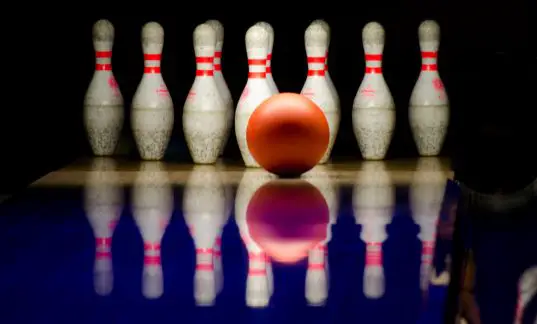Most North American bowlers are familiar with ten-pin bowling alleys but are unlikely to know the exact specifications and dimensions of the lanes they’re playing on. We’re here to give you a reference point on the sizes and nuances of the lanes you know and love, while also giving bowlers around the world an informative look at the dimension of lanes for different versions of the game.
There are five generally understood and accepted variations of bowling around the world — ten-pin bowling, nine-pin bowling, candlepin bowling, duckpin bowling, and five-pin bowling. Ten-pin bowling alleys can be found in most developed areas around the world, while the other four game styles are more specific to different regions. We’re going to break down the bowling alley lane dimensions for all five games in depth, giving you the standard specifications for alleys around the globe.
One note — some bowling alley operators modify the size of their lanes for various reasons. We won’t be covering custom lanes. Rather, we’ll be tackling the regulation bowling lane specifications for each of the five bowling games listed above.
Ten-Pin Bowling
A regulation ten-pin bowling lane is 60 feet in length and 42 inches wide from left to right. For reference, we consider the length of a ten-pin bowling lane to be from the foul line to the head pin. Therefore, a regulation ten-pin bowling lane is 60 feet long from the foul line to the pins.
In the area behind the foul line are two sets of approach dots where most bowlers begin their shot. These approach dots are located 12 feet and 15 feet from the foul line. Using these approach dots will help you time your steps and keep you from fouling by stepping over the line during your release.
There’s a set of seven offset arrows 15 feet past the foul line which most bowlers use to set their line for a shot. To be clear, the center arrow is the point we use to measure from foul line to arrows. Some bowlers would rather use the pins as their focal point when shooting, but using the arrows can be a much better bet for those with visual impairments or those who are having control issues.
Each ten-pin bowling lane is bookended by two gutters which drop 1 7/8″ below the lane and measure 9 1/4″ in width. A 9 1/4 inch wide gutter is wide enough to fit any regulation bowling ball with enough room on both sides for it to travel at full speed without sticking.
Looking at a ten-pin bowling lane from a width perspective, each regulation lane consists of 40 thin boards running length-wise down the alley. For those bowlers who want a more acute alignment system for setting up shots, using a particular board can help a bowler zero in and find their complete mark for major action on the back end.
Each regulation ten-pin bowling lane has a tail plank — a board located at the rear of the pin deck which serves to shelter a pin deck from damage. A regulation tail plank maxes out at 2 inches thick. An accompanying pin cushion which softens the fall for pins measures 9 7/8″ thick.
All in all, the bowling equipment for a lane takes up about 87 feet length-wise. That includes the lane itself, the approach area, and the space for the bowling machine and bowling ball return.
As for the bowling surface of a ten-pin lane, most lanes are made of synthetic materials, wood, or a hybrid of synthetic materials and wood. Each lane has its own variation of an oil pattern which protects the lane and adds nuances to the reactivity of the surface. Any oil pattern which meets or exceeds 42 feet in length is considered a long oil pattern.
Now that we’ve covered the most popular type of bowling lane in the world, let’s tackle some lesser known versions of bowling and their lane measurements.
Nine-Pin Bowling

Nine-pin bowling alleys are rarely found outside of Europe, although some communities in Central Texas with large German immigrant populations play home to this unique version of the great sport of bowling.
As for the lanes themselves, nine-pin lanes measure at a length of 64 feet from the foul line to bowling pins. Ninepins is also unique compared to ten-pin bowling for the string which runs across the foul line. A legal shot must pass under the string for it to count. In addition to the string, regulation nine-pin lanes do not have gutters.
For most nine-pin lanes, the width is the same all the way down. In some regions of Germany, however, a Scherenbahn (or scissor lane) is used. A scissor lane is much narrower at the front of the lane and widens as you get closer to the pins. They are the also the only type of ninepins lane which features gutters.
Candlepin Bowling

Candlepin bowling is a unique variation of the sport which is mostly exclusive to New England in the United States and the Canadian Maritime provinces. Candlepins are much thinner than normal bowling pins and aren’t cleared off the lane in the middle of a turn.
As for the dimensions of the lanes themselves, they are almost identical to those used in ten-pin bowling. They are 60 feet in length from foul line to head pin, but they’re actually only 39 boards wide with a width of 41 inches — one inch less than that of a regulation candlepin lane. This gives the lane a center board which many use as a guide for their shots. The approach area for candlepin bowling is the same as that for ten-pin bowling.
Candlepin balls are much smaller than normal balls, contributing to the increased difficulty of this variation. To make up for this just a bit, you get three shots per frame instead of two.
The lane surface of most candlepin bowling lanes is maple. Synthetic lanes have not made their way into the sport as of yet. A very weighty backstop covered with a black curtain is used to catch pins after impact and direct them into the pin pit.
Duckpin Bowling

Duckpin bowling is another unique variation of the sport which centered mostly in the New England region of the United States. There are duckpin alleys in 9 U.S States, with 8 of them in New England proper.
Duckpins are shorter and squatter than normal pins, and duckpin bowling balls are much smaller than regular bowling balls and have no finger holes. As with candlepin bowling, bowlers get three attempts per frame instead of two and scoring is quite similar to that of ten-pin bowling.
As for the dimensions of the lanes, they are nearly identical (if not completely identical) to those used in candlepin bowling. They match the length of a 60-foot regulation ten-pin lane from the foul line to head pin, but are 41 inches wide instead of 42. The approach area for duckpin bowling is the same as for candlepin and ten-pin.
The widths of duckpin/candlepin lanes and ten-pin lanes are negligibly different in theory, but the loss of an inch can throw your game out of step and take away your normal target used in a ten-pin bowling session.
Five-Pin Bowling

Created by Thomas F. Ryan in 1909 in response to complaints from bowling alley customers who thought ten-pin bowling was too stressful, five-pin bowling is pretty much exclusive to Canada. In fact, a fair amount of normal ten-pin alleys in Canada offer five-pin bowling as an option.
The scoring system is much different than ten-pin bowling, although it’s similar to candlepin and duckpin in that a player gets three shots per frame. The balls are small enough to fit in a player’s hand and have no finger holes.
As for the lane dimensions in five-pin bowling, they range in length from 60 feet to 62 feet, 10 inches. An accepted five-pin lane can be anywhere for 41 inches (identical to candlepin/duckpin) to 42 inches (identical to ten-pin bowling) in width.
Gutters are anywhere from 9 inches to 9 1/2 inches wide, but are usually deeper than those surrounding a ten-pin lane with a depth of 2 3/4 inches to 3 1/2 inches. However, some regular ten-pin bowling alleys are used for the game in Canada, thus utilizing the regular dimensions for ten-pin bowling rather than that of the five-pin variation.
Closing Thoughts
The dimensions listed above are not guides to better play, but knowing your surroundings (and overall spatial awareness) in bowling is crucial to being comfortable and finding your groove. The five sections above are chock full of interesting facts about bowling lanes, so feel free to use them as icebreaker material at your next dinner party or while putting on your bowling shoes with friends at the local bowling alley.

